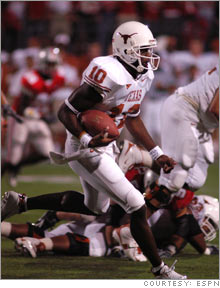Texas is the BC$ champ, too
Even before their stunning upset of USC, the Longhorns were big winners where it matters.
NEW YORK (CNNMoney.com) - Two college football powerhouses met in the national championship game Wednesday night, and one of the programs was superior in more ways than one. And even though the score on the field was a taut 41-38, when it comes to money, the University of Southern California doesn't nearly come close to measuring up to the University of Texas.
According to reports filed by 55 of the 56 bowl teams with the Department of Education (Navy is exempt from filing) the University of Texas is the nation's richest, and most profitable football program, with revenue of $53.2 million, and a profit of $38.7 million, during the fiscal year that ended in August, just as the current season was about to get underway. To put this into context, Texas' profit from football is more than the revenue of all but eight of the other schools in this year's bowls. Defending champ USC, by comparison, is not one of those huge-revenue schools, despite its 34-game winning streak and status as the heavy favorite going into the Rose Bowl. USC had revenue of "only" $29.3 million during last year's championship season, (which ranked it 14th among current bowl contenders) and a profit of $12.6 million (good enough for 13th). That's not to say that Texas' financial edge gave it an edge on the field. In fact, eight of this year's 28 bowl games went to the football programs with lower revenue, while 10 of the games went to the school with a smaller profit on the gridiron. But given the financial might of Texas' program, maybe its win shouldn't have been such an upset. USC's profit as a percentage of revenue is just 43 percent, below the average of 48 percent for all the reporting bowl teams, even when you include the 11 schools which lost money on their football programs. The top 20 football programs in terms of revenue have profit margins of about 60 percent, on average. Even the NFL would be envious of those numbers. Profit margins for Texas, on the other hand, are nearly 73 percent. And that is one of the few financial measures where the school is not No. 1, falling slightly behind the University of Georgia (77 percent) and the University of Michigan (75 percent). And Texas' financial might doesn't even factor in the benefits it gets from being one of the top schools in terms of license merchandise sales, much of which is not specifically football related. The Collegiate Licensing Company, which handles brand management and development for about 200 major colleges, puts Texas as No. 1 in terms of licensed merchandise sales, although the service does not have some top schools including USC, Ohio State and UCLA as clients. Schools aren't bowled over by bowl $
What may come as a surprise to football fans is that the bowl games themselves are not a big driver of profits for most schools. The teams that go to the bowls generally have to share these payouts with the other schools in their conference. Big Ten powerhouse Ohio State had to share its $15.75 million check for making it to the Fiesta Bowl with the other Big Ten schools. But Ohio State's opponent, Notre Dame, as an independent (non-conference) school, got to keep the full $15.75 million. So clearly, the South Bend school was the big financial winner of this year's bowls, even though it lost to Ohio State. Schools also often have to pay substantial travel expenses for a large contingent that includes players, coaches, band members, cheerleaders and others. Add in ticket purchase requirements and many teams going to less prominent bowls lose money on the trip. Not surprisingly, the schools that play in the non-BCS conferences, the ones that are scrounging for invites to bowls that pay a fraction of the BCS payouts, start and end the year at a huge dollar disadvantage. Take the Mid-American Conference's University of Akron Zips, which played in the Motor City Bowl. The appropriately named Zips are anti-Longhorns. The school's football program was the only one among this year's bowl participants to take in less than $1 million in revenue last year and its $2.9 million reported loss was just a hair smaller than that reported by the University of Central Florida. For a look at the debate over the college bowl system, click here.
For a look at more news about the business of sports, click here. |
| |||||||||||||



